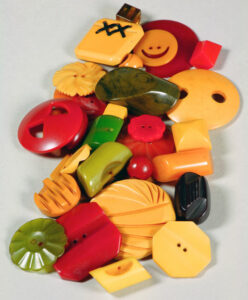Table of Contents
Overview
Bakelite has been created by combining phenol and formaldehyde (phenol-formaldehyde resin), two compounds derived from coal tar and wood alcohol (methanol) at the time. It thus made it the first truly synthetic resin, a significant advancement over previous plastics based on modified natural materials. Bakelite was also the first commercially produced synthetic resin, replacing shellac and hard rubber in parts for the electric power industry as well as in-home appliances due to its excellent insulating properties. It was widely used in radio knobs, dials, circuitry panels, and even radio cabinets in the 1920s, and it was also used in automotive electrical systems. In the 1930s, cast Bakelite, like many other competing phenolic resins, was popular in colourful costume jewellery and novelty items. Bakelite.

Bakelite material
It is the first synthetic plastic. This is a thermosetting phenol formaldehyde resin formed by a phenol-formaldehyde condensation reaction. Leo Baekeland, a Belgian chemist, invented it in Yonkers, New York, in 1907.
It was a huge commercial success due to its electrical nonconductivity and heat resistance. So that, it was used in electrical insulators, radio and telephone casings, and a wide range of other products including kitchenware, jewellery, pipe stems, children’s toys, and firearms. Old Bakelite products have become collectable due to their “retro” appeal.
The development of synthetic plastic was revolutionary for the chemical industry, which made the majority of its money from cloth dyes and explosives at the time. The commercial success of Bakelite prompted the industry to invest heavily in the development of other synthetic plastics. Bakelite was designated a National Historic Chemical Landmark by the American Chemical Society on November 9, 1993, in recognition of its significance as the world’s first synthetic plastic, which transformed the chemical industry.
Bakelite is created in a multi-stage process. The process starts with the heating of phenol and formaldehyde in the presence of a catalyst such as hydrochloric acid, zinc chloride, or ammonia base. This finally results in the creation of a liquid condensation product known as Bakelite A, which is soluble in alcohol, acetone, or additional phenol. When the product is heated further, it becomes partially soluble and can still be softened by heat.
A “insoluble hard gum” is formed as a result of prolonged heating. Even so, when done at standard atmospheric pressure, the high temperatures required to create this cause violent foaming of the mixture, resulting in the cooled material being porous and breakable. Baekeland proceeded next step by placing his “last condensation product” in an egg-shaped “Bakelizer.” Baekeland was able to suppress the foaming that would otherwise occur by heating it under pressure at around 150 °C (300 °F). The resulting substance is extremely hard, insoluble, and infusible.
Use of bakelite
- Bakelite’s physical and chemical properties made it especially suitable as a moulding compound, an adhesive or binding agent, a varnish, and a protective coating. Because of its extraordinary resistance to electricity, heat, and chemical action, bakelite was particularly well suited for the emerging electrical and automobile industries.
- It’s jewellery was popular in the past because it could be made in a variety of colours. Colourful bangles, earrings, and bracelets were popular. Artificial jewellery made of metals or other alloys may occasionally cause allergies or skin irritation, but carefully manufactured Bakelite jewellery is completely safe to wear, giving it an advantage in the market.
- Bakelite is widely used in a variety of items such as buttons, toys, washing machine impellers, clocks, kitchenware, and so on.
- It use is less common today than it was years ago, but it is still effective. There are numerous potential market replacements for low-cost Bakelite. Bakelite was invented in the early twentieth century, but it is still an important subject to study in the twenty-first. Bakelite characteristics are investigated, as well as information about its commercial use. Polymers are commercially available due to Bakelite’s physical, chemical, electrical, and thermal properties.
Bakelite colours
“Black, brown, red, yellow, green, grey, blue, and blends of two or more of these” were among the colours available. It is available in a variety of forms to meet a variety of needs. Even without testing, Bakelite in solid colours is the most recognisable type.
Huge strands of red Bakelite beads can sell for $4,000 or more and are among the most valuable items to collectors, owing to the cherry amber colour’s scarcity and the simple design’s wearability.
Bakelite could be moulded, making it superior to celluloid in this regard while also being less expensive to produce. Its quick mouldability allowed for a great advantage in mass-production processes where many identical units were consecutively produced. Bakelite is really a thermosetting resin, which means that once moulded, it keeps its shape even when heated or exposed to various solvents.



